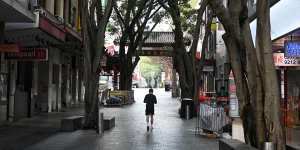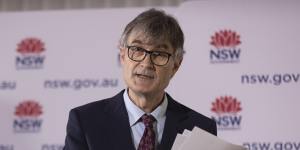A review is under way to amend how health authorities target areas with rising case numbers,addressing concerns that alternatives to blanket lockdowns for local government areas could be needed in future outbreaks.

A quiet Chinatown on Tuesday. Authorities say it’s too early to determine whether infections have peaked.Nick Moir
Liberal MPs have been urging Premier Gladys Berejiklian to rethink the boundaries dividing Sydney and release suburbs with low case numbers from harsher settings.
But modelling from the Burnet Institute released on Tuesday said harsher restrictions,and not rising vaccination rates,had the greatest impact on slowing the spread of coronavirus in south-west and western Sydney.
Under present restrictions,the institute said case numbers in other parts of Sydney would soon overtake the hotspots and warned against relying solely on vaccination to halt the spread.
“It may be necessary to impose greater restrictions ... at least,in some of the LGAs with higher growth rates to curb this growth,” the report said.

Daily numbers in Sydney hotspots plateaued only one week after restrictions,including curfews,store closures and one-hour outdoor exercise limits,were introduced on August 23,the modelling found.
“Without these stricter measures,we expect about 2000 cases per day by now and about 4000 per day by the end of the month instead of the 1000 per day currently in these 12 LGAs,” the Burnet,a medical research organisation in Melbourne,found.
The analysis was not commissioned by the NSW government. It is separate from Burnet modelling released by the state government last week,which was conducted in August to predict the growth of the outbreak in this period and over the next three months.
Tuesday’s modelling reveals “what’s actually happened”,said Professor Allan Saul,who worked on the project.
“This shows what worked and the implications in the future. We have seen a very sharp transition around August 29,when we expected to see the extra restrictions of August 23 take effect,” he said.
NSW reported 1127 new local cases and two deaths on Tuesday. Numbers are down on Monday’s figures,but authorities said it was too early to determine whether infections had peaked. The reproductive rate is ranging from 1 to 1.2.

Deputy Chief Health Officer Jeremy McAnulty fronted the media in the first COVID-19 update without Ms Berejiklian or a government minister since she announced an end to daily press conferences last week.
There are 1253 coronavirus patients admitted to hospital,with 231 in intensive care and 104 who require ventilation.
NSW is expected to hit 80 per cent first-dose vaccination coverage in people aged 16 and over on Wednesday following a significant push for shots in hotspots over the past two months.
Dr McAnulty said a rapid increase in immunisation in areas such as Cumberland Council,in Sydney’s west,could have contributed to declining numbers.
Vaccine uptake has also jumped dramatically in hotspot areas such as Burwood,Campbelltown and Fairfield,where first dose coverage has increased by 64-65 percentage points in less than two months.
University of Queensland vaccine researcher and infectious disease physician Paul Griffin said there was “no question” vaccination was having an impact on Sydney’s numbers,but said it was going to be “a combination of everything that’s been done”.
Case numbers continue to rise in inner-city suburbs such as Redfern and Waterloo,but there have been no moves to name them as areas of concern.

NSW Health’s Dr Jeremy McAnulty provided Tuesday’s COVID-19 update.Anna Kucera
Dr McAnulty said the hotspots are assessed daily,with case numbers,trajectories,immunisation rates and levels of movements among key factors examined.
In Sydney’s west,Liberal member for Riverstone Kevin Conolly joined MPs calling on the Premier to lift some hotspot suburbs from harsher restrictions and to apply them by suburbs and not LGAs.
“I think it’s time for the suburbs of northern Blacktown to be released because case numbers are coming down,” he said.
Riverstone resident Kristin Carville said his 2765 postcode was unfairly captured by the lockdown covering Blacktown LGA despite having low case numbers and high vaccination.
“Our postcode covers eight suburbs which are spread across four LGAs. There are four suburbs in Hills LGA,two in Blacktown,one in Penrith and one more split between Hawkesbury and Blacktown,” Mr Carville said.
“You have a situation where potentially the majority of the cases for this postcode are in the Hills LGA,however it is Blacktown LGA that suffers.”
Opposition and crossbench members of the NSW upper house also failed to trigger a return to Parliament on Tuesday after a short debate calling on the government to reverse its decision to delay the return until October 12.
The upper house had been scheduled to sit in accordance with a COVID safety plan but was unable to proceed because no minister or parliamentary secretary was present,as per the Premier’s decision.
Finance Minister and leader of the upper house Damien Tudehope said it was “a political and selfish stunt” for members to attend Parliament on Tuesday,putting staff and communities at risk.
Leader of the opposition in the upper house Penny Sharpe said the sitting of Parliament was more important than ever because the Premier had ended her daily updates.
The Morning Edition newsletter is our guide to the day’s most important and interesting stories,analysis and insights.Sign up.